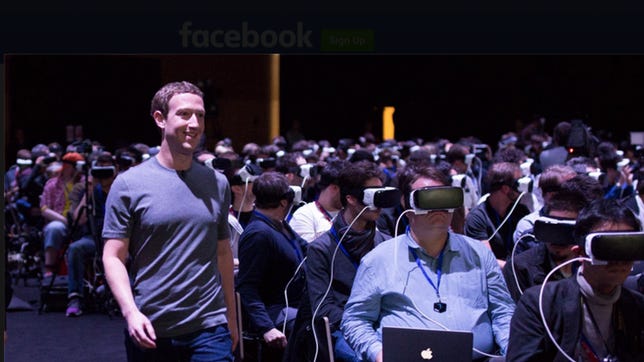Few people have tried virtual reality, but it’s already become a meme.
Earlier this week, a photo went viral showing Facebook CEO Mark Zuckerberg striding past unsuspecting journalists strapped into virtual reality headsets. Reactions ranged from comparisons to “The Matrix” to the observation that Zuckerberg may be our new overlord.
The occasion was a Samsung press conference for the unveiling of its new flagship phones. Still, it’s fitting that Zuckerberg’s moment was the one to become a cultural touch point. The collective response underscores the growing relevance of VR technology, which immerses you in any manner of digital worlds. With consumer-focused products starting to arrive after years of hype, virtual reality is finally much closer to actual reality.


Facebook CEO Mark Zuckerberg makes a surprise appearance at MWC 2016, as unsuspecting journalists experience virtual reality.
Facebook
“‘Virtually reality is going to change the world in the next five years’ has been a mantra in the tech community for the past 30 years,” said Macquarie analyst Ben Schachter. “This time it certainly seems like it is closer to being real.”
For a trade show that’s supposed to be about phones and other mobile devices, this week’s Mobile World Congress in Barcelona served up VR nearly nonstop. Samsung’s booth featured a virtual reality roller coaster ride, complete with moving seats. Next door, the SK Telecom booth offered a VR submarine experience. HTC unveiled the pricing and look of its Vive VR system. And in countless booths you could see headsets from VR wunderkind Oculus, a unit of Facebook.
To be sure, there are still plenty of challenges to overcome. The early experiences are expensive. You may even have to buy a pricey PC to go with your pricey headset. The quality of the graphics isn’t consistent and can be downright headache-inducing with the wrong equipment. There’s also a question of how much VR content will be available.
But that didn’t dampen the enthusiasm at the show.
Whatever sticks
When Jefferson Wang, who leads mobile innovation for IBB Consulting, polled a room of several hundred top mobile executives here, he found two-thirds said they were already involved or planned to get involved with virtual reality.
Then he asked how many of them had a strategy for VR. Nearly three-quarters of the room admitted they didn’t.
The statistic suggests that a lot of virtual reality products may end up being one-offs or eventually landing in the back of consumers’ closets.
“We’re moving at a pace so fast, looking for the next big thing, that we may discard the next big thing,” Wang said.
That’s not to say companies aren’t serious about this technology. Taiwanese phone maker HTC, which on Sunday revealed the $799 price tag for the Vive, has bet big on the area. It fielded lines around its booth as people tried its demo.
Vive: What your $799 ticket to VR includes (photos)






“Everyone is overwhelmed,” HTC CEO Cher Wang said in an interview. “They’re just: ‘Wow.'”
Likewise, both Samsung and LG showed off new 360-degree cameras that will feed wraparound images into virtual reality headsets. Neither discussed price, but their devices are designed for average consumers in order to encourage content creation.
Innovations galore
Some on the MWC show floor offered a glimpse of where virtual reality can go.
Two separate companies demonstrated eye-tracking technology, installed in modified Oculus Rift and Samsung Gear VR headsets. Their systems allow you to navigate the virtual world with a flick of your eyes instead of the tilt of your head or the squeeze on a handheld controller.


Now playing:
Watch this:
CNET puts team VR to the test in virtual Mars mission
1:15
Eye-tracking capabilities have been around for years but could gain new relevance with VR.
In another hall, the Institute of Electrical and Electronics Engineers, which sets standards for things like Wi-Fi, was working with developer Globacore. Together, they linked three Oculus systems to create a mini-game in which a player worked with two fellow pilots to get a Mars rover to its shuttle. The game wedded physical cockpit controls with the headset and a virtual Mars environment to complete the experience.
“It’s an opportunity to take things further,” said Simon Conlin, the producer at Globacore who created the game.
On a more practical level, developer Summit Tech showed off the ability for people to use any virtual reality headset to talk to each other using a standard cellular network and tech called voice over LTE. With its app, you would be able to take calls while on the VR headset and even share what you’re seeing with the person on the other phone.
That capability is in trials with one North American carrier now and will be commercially available in the fourth quarter, according to Summit Tech CEO Alido Di Giovanni.
Beyond the hype
The next step will be getting more people to use this tech.
Samsung will throw in a free Gear VR, normally priced at $99, to anyone who places an early order for a new Galaxy S7 or S7 Edge phone. The phones go on sale on March 11, and the Gear VR has been out since late November.
The Oculus Rift and HTC’s Vive go on sale in the coming weeks. Retailers have been willing to donate retail space for the Vive because of the excitement and foot traffic it will generate, said HTC Chief Financial Officer Chialin Chang.
Oculus, meanwhile, will get the full backing of the world’s largest social network.
“Facebook and Oculus are committed to this for the long term,” Zuckerberg said at the Samsung event.
That’s good, because as far as virtual reality has come, it’s still a big leap from the show floor to your living room.


Now playing:
Watch this:
Hands in the air! CNET rides Samsung’s VR roller coaster
1:15



